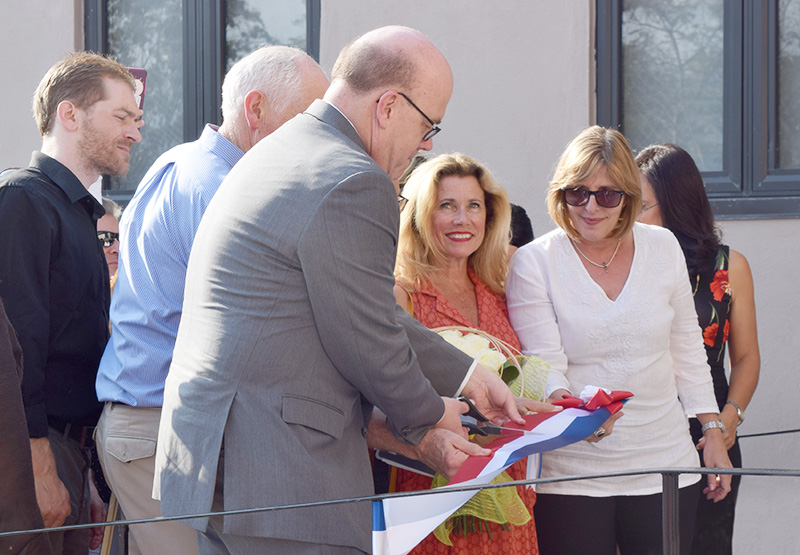We are pleased to announce the Opening of the Conservation Center at Finca Vigía. After a five-year construction project, the building is complete. A Commemoration Ceremony was held on March 30, 2019.
The ceremony, attended by Finca Vigía Foundation board members, members of the technical team, and many representatives of the Cuban Council of National Patrimony.
The national anthems of both nations were played prior to the official remarks. Gladys Collazo President of the Consejo Nacional de Patrimonio Cultural welcomed all guests. Speeches were made by Congressman James McGovern chairman of the Foundation’s advisory committee, Frank Phillips, co-chair of the board of directors, and Mary-Jo Adams, executive director of the Foundation. The common theme was collaboration.
Feature Photo Above: Congressman James McGovern, chair of the Advisory Committee and Gladys Collazo, President of the Consejo Nacional de Patrimonio Cultural cut the ribbon of the Conservation Center.
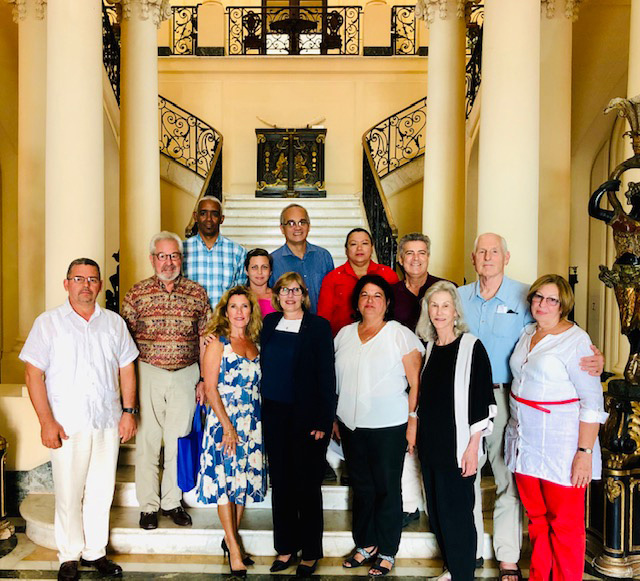
The executive committee of the board of directors of the Finca Vigía Foundation with leadership of the Consejo Nacional de Patrimonio Cultural at the Museum of Decorative Arts in Havana.
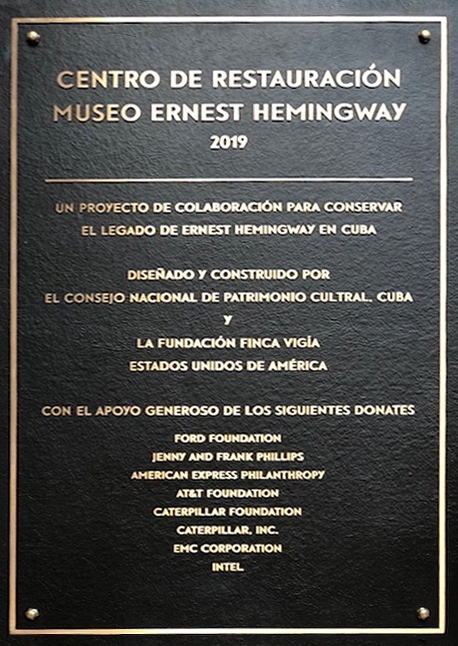
Dedication Plaque
Following the program, all toured the Conservation Center. Original Hemingway documents were displayed in the dry laboratory as conservators from both nations described the treatments plans needed. Attendees also entered the wet laboratory and the archival storage vault. Outside the vault is a plaque honoring the memory of Dr. Marta Arjona, former president of cultural patrimony and Dr. Jenny Phillips, founder of the Finca Vigía Foundation and granddaughter of Hemingway’s editor Maxwell Perkins. This was the first and the last time that the building will be open to the public in such a way.
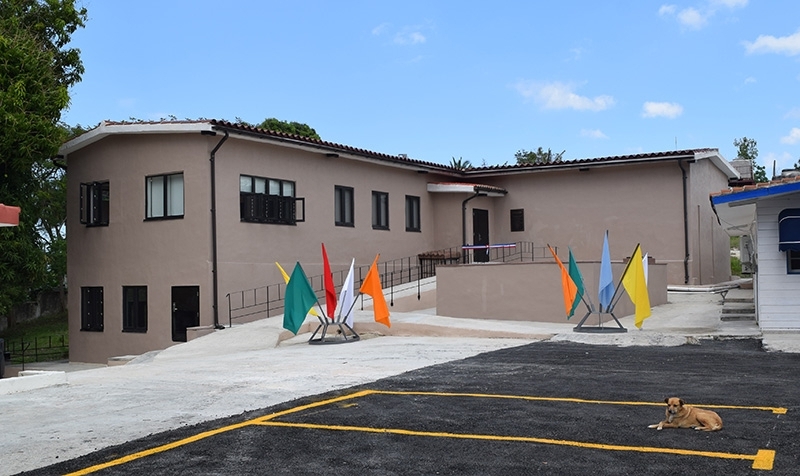
The exterior of the Conservation Center at Finca Vigia.
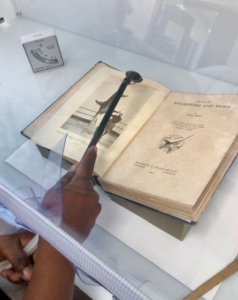
Book cleaning. Using the fume hood to surface clean one of Hemingway’s books.
Many people from both nations made this remarkable achievement possible. The following is the text of the speech delivered in Spanish and English by executive director, Mary-Jo Adams, in which supporters are acknowledged and thanked.
Good afternoon, everyone.
It is a great honor for me to speak on this historic occasion … the Commemoration of the Conservation Center at Finca Vigía. Thank you for the opportunity.
My name is Mary-Jo Adams and I have had the pleasure of directing this extraordinary, international collaboration on behalf of the Finca Vigía Foundation of the United States since 2004. It is a privilege to work with many brilliant and talented Cuban and American colleagues. Many of whom I see before me.
The Finca Vigía Foundation does not accept government money—however, we are all grateful to the United States government who since 2005 gave us permission to execute our work. And we are grateful to the government of the Republic of Cuba, who also allows us to work.
All work done in Cuba by our Foundation, was done with the guidance and wisdom of the Board of Directors. Without their steadfast commitment in this project we would not have succeeded. I personally want to thank those that traveled here today, Bob Vila, Frank Phillips, Vicki Huddleston, Deborah Harding, Sandra Spanier, Andres Gil, William Osborne, and Fran Soistman. You have guided me for many years. I am grateful.
Architectural preservation, document conservation, and construction of new facilities take resources. I would like to thank the donors who have financially supported us. Without their belief in this collaboration, aided by their generous financial support, we would not be here today. The Ford Foundation, Rockefeller Foundation, and the Kaplan Fund joined us in our very early years. EMC Corporation represented here by Joel Schwartz provided the majority of the funds for document conservation work—aided by Intel and Emulex.
The Conservation Center which we will tour shortly, was funded by American Express (Richard Brown is with us today), Caterpillar Inc., Caterpillar Foundation, Ford Foundation, AT&T Foundation, and the Jenny and Frank Phillips Family . We have members of the Phillips family with us—Frank, Max, Polly, Jake, Emily, Max, and Peggy. Jenny, sadly, died this past summer. I want to thank our attorney Michael Gurdak from Jones Day … and many smaller contributions from individuals from almost all 50 states. Hemingway unites many people. We are grateful to them all.
This collaboration between our Foundation and the Consejo Nacional de Patrimonio Cultural was the strategic dream of two incredible women—Dra. Marta Arjona, former of President of Consejo Nacional de Patrionio Cultural, and Dra. Jenny Phillips, granddaughter of Hemingway’s illustrious editor Maxwell Perkins.
These two women, from different nations, had many things in common. They were strong, intelligent, and determined. They pursued their dreams however unique, and both refused to take “no” for an answer. It is due to their combined will and determination that we are gathered here today.
The first document accord was coordinated and organized by Dra. Arjona and Dra. Phillips, and others—notably Congressman James McGovern, Gladys Rodriquez, the Social Science Research Council, and the John F. Kennedy Presidential Library. Our Foundation was asked to help with the conservation of thousands of valuable Hemingway documents, photographs, and books.
We sent document conservators from the Northeast Document Conservation Center in Massachusetts to Cuba. As determined by the accord, original Hemingway documents remain in Cuba, and digital images of all documents are brought to the Kennedy Library in Boston.
Since that signing in 2002, witnessed and signed by President Fidel Castro, the scope of the collaboration grew. With the assistance of Richard Moe and the National Trust for Historic Preservation in Washington D.C., the Finca Vigía Foundation obtained permission from the US government to consult on the preservation of Hemingway’s home.
From that moment on, working shoulder to shoulder with Cuban specialists from CNPC in engineering, architecture, and museum studies—US team leader William Dupont and his group together crafted strategies to address preservation issues related to age and climate. In two years the home was preserved and returned to the original splendor of Hemingway’s days. The labor was 100% Cuban.
As the years progressed, other projects were undertaken under the careful eye of Presidenta Margarita Ruiz Brandi. The Pilar was restored. Five document accords were signed, each reflecting advances in technology and needs of the Museo Hemingway. The Hemingway kitchen was transformed into a data-imaging laboratory. Consultants from the United States taught best practices in the use of metadata, photograph and book conservation, and assisted Cuban conservators in the delicate conservation of 5 Hemingway scrapbooks. Many people participated in the conservation effort—I would especially like to thank the two lead conservators Walter Newman from the United States, and Nestor Garciaga from Cuba.
The shared mission sustained all of us involved in the project. Over time, we stopped thinking of ourselves as the Cuban team or the American team. We were one group, working hand in hand to preserve the legacy of Ernest Hemingway in Cuba.
How was this possible? Weren’t our two countries at odds with one another? It did not seem that way to me. This was about Hemingway. Culture. A deep and abiding respect for one another grew stronger each year.
The path was not always straight or easy. All of us—Cubans and Americans had to deal with obstacles from time to time. Obstacles that were out of our control. We were honest with one another. Direct. We spoke the truth. We trusted one other.
Throughout the conservation of documents, we all acknowledged a flaw: a final safe storage vault for Hemingway documents did not exist. That is no longer the case.
Again, I must offer praise to the governments of the United States and Cuba, who understood that Hemingway was a citizen of both nations. Both nations worked to ensure that a conservation center could be built using US materials, which until now, had not been legal. Congressman McGovern helped tremendously in the United States as well as the Cuban Ambassador Jose Cabanas in Washington and the Ministry of Culture in Cuba.
William Dupont convened a group of engineers and construction specialists from the United States to work with engineers, architects, and specialists from the Consejo Nacional de Patrimonio Cultural to design the building.
Christman Company from Detroit Michigan, represented today by Ronald Staley was masterful in calculating the materials needed and organizing the 5 shipping containers over two and a half years. Christman Company sent groups of construction specialists, usually accompanied by Manuel Martinez to assist with mechanical, electrical, and all phases of construction.
Christman Company was joined by the talented team from Cooperativa Santa Fe whose president, Domingo Robles Ramirez is with us today, as well as Superintendent Salvador Cespedes and others. Thank you.
President Gladys Collazo and her talented staff oversaw all the work. Her strategic thinking and planning was invaluable. It is a pleasure to work with her dedicated staff– Alain Vicens, Dinorah Fernandez, Karalys Guerrero and others whose work we appreciate. And of course I want to thank the current director of Museo Hemingway Grisell Fraga, her deputy Director Isbel Fererio, and past director Ada Rosa Alfonso.
The Conservation Center we will see today is a beautiful building, with wet and dry conservation laboratories, and a climate controlled archival storage vault for the irreplaceable Hemingway collection.
The building is practical, efficient, state of the art for certain …. but to me and I think to others, is so much more. It is a symbol—a shining example of what can be accomplished when good people work together. When people share opinions and respectfully find solutions.
We trust it will be a model for what can be accomplished in the future by Cubans and Americans working together.

